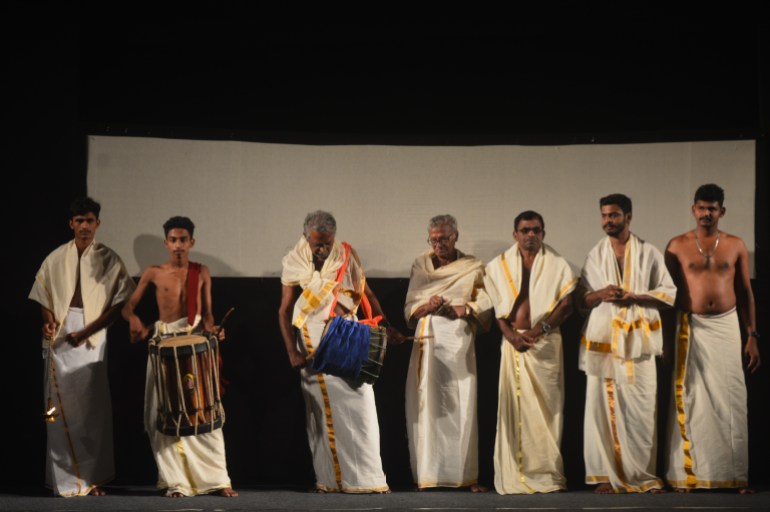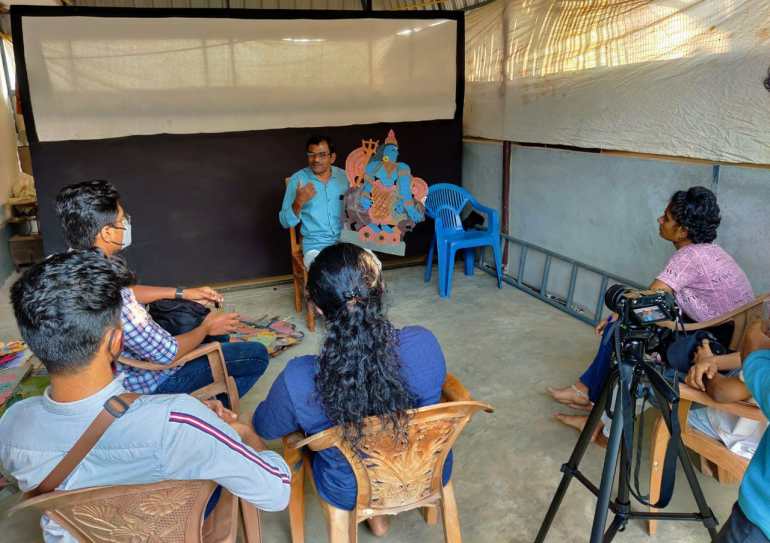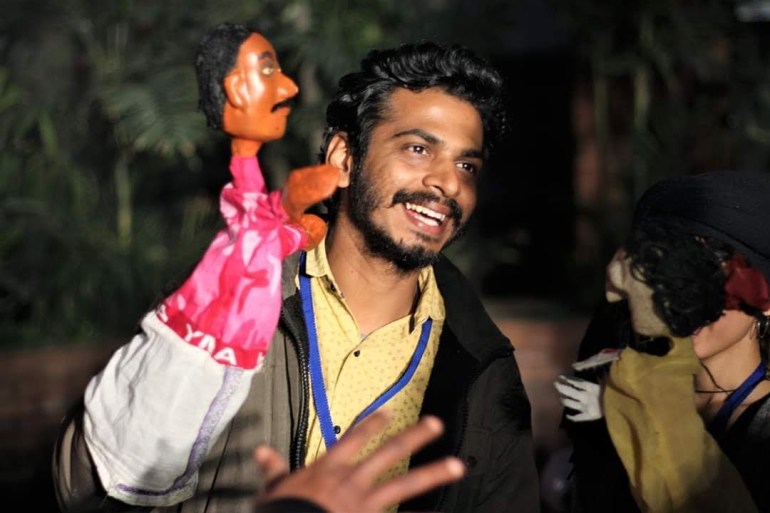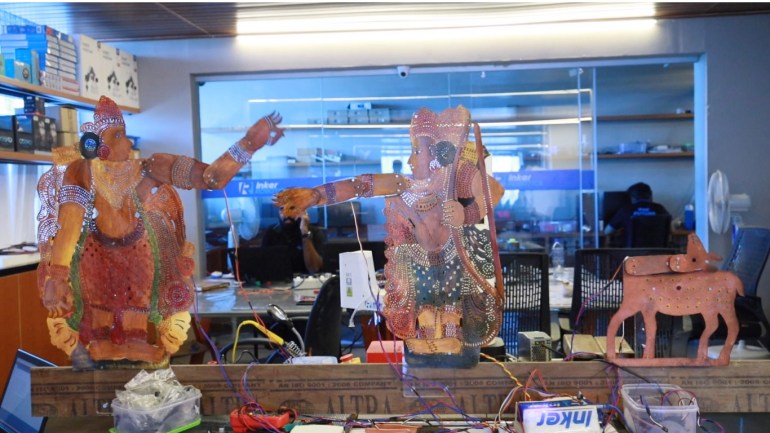Koonathara, Palakkad – A cool breeze, moving prayer verses and eye-catching puppets mesmerize the audience of over 25 people seated in chairs under the night sky of Koonathara, a village in the Palakkad district of Kerala, India. They are a mix of locals and tourists from all over the world.
Tholpavakoothu (thol meaning leather, pava meaning puppet and koothu meaning game) is a form of shadow theater performed at events and festivals held in temples dedicated to the goddesses Durga or Kaali. This art form is only found in Palakkad, Thrissur and the neighboring villages of Kerala.
Performed three to four times a month between January and May, a special 42-foot-long stage called a koothumadam is set up on the temple premises. It displays mythological figures backlit by fire or lights behind a screen.
The festive air is palpable as a rhythmic drumbeat begins and the performers step out with a lit lamp. Fireworks sound to announce the start of the performance and then, in the total darkness except for the light of the lamp, a feeling of calm reigns.
A row of 21 wicks placed in coconut shells is lit behind the screen, made of white fabric stretched across the koothumadam, edged with black fabric.
Tholpavakoothu is based on Kamba Ramayana (the Tamil version of the epic Ramayana), which tells the story of the Hindu god Sri Rama from his birth to his coronation as king of Ayodhya.
It is said that the tholpavakoothu is performed to please the goddess Bhadrakali, as she was unable to witness the murder of demon king Ravana by Rama, which is why an idol of the goddess is placed on a pedestal in front of the stage.
About 160 puppets are used to represent the approximately 70 characters of Kamba Ramayana, told in a diction which is a mixture of Malayalam and Tamil, with songs and poetry called Adalpattu.
Ten artists – the master puppeteer, singers, storytellers and other puppeteers – are highly skilled in this art form.
Lakshman Pulavar, 62, is one of them. He has been performing since his childhood, following in the footsteps of his father, grandfather and those who came before them.
His family is the sole custodian of this 300-year-old art form and has practiced it for eight generations.
The master puppeteer is called the “pulavan”, which derives from their surname Pulavar, meaning learned scholar.
The leather puppets, which are around 80 cm high, are made by Lakshman and his sons, with the help of other family members. They are cut from buffalo and deer skins, painted with vegetable dyes and tied with sticks.
Handling them takes dexterity and concentration and is one of the most difficult parts of the performance, in which a total of 2,100 verses and their meanings must also be memorized.
 A show team in front of a stage [Sajeesh Pulavar/Al Jazeera]
A show team in front of a stage [Sajeesh Pulavar/Al Jazeera]In total, the Pulavar family performs in 82 temples in Palakkad, with Lakshman and his sons responsible for 20 temples, and his brothers and cousins covering the rest.
The performance normally lasts 21 days around the Pooram, the annual festival which falls the first week of April, but can last even longer. The family also presents other shows in which different stories are told at events and functions around Palakkad. These performances are shorter, some only last 30 minutes, and require fewer artists.
“Artists have to undergo years of rigorous training before they master this art form,” says Lakshman, who is in the process of training students and holds a puppet in his hand as he speaks. “It took me a long time to recite all the verses verbatim,” he adds.
“I like to be part of it”
The Harisree Kannan Tholpavakoothu Kalakendram in Koonathara is an institute dedicated to tholpavakoothu performances and is run by Lakshman and his sons, Sajeesh, 31, and Sajith, 22.
The institute organizes training sessions and summer camps to teach art, as well as puppet making, training 10-20 adult students and 150-200 schoolchildren at any time. They also organize workshops for international students studying Indian culture. Since the pandemic, Sajeesh has been teaching online using a makeshift scene in his home.
 Lakshman Pulavar during a training session with his students [Sajeesh Pulavar/Al Jazeera]
Lakshman Pulavar during a training session with his students [Sajeesh Pulavar/Al Jazeera]“The drumbeats and the music add a feeling of euphoria and excitement to the performance, and I love being a part of it,” Sajith says, his eyes twinkling as he speaks.
His brother Sajeesh left the village to study mechanical engineering and work for an automotive company, but soon returned to continue the family tradition.
“I learned the art of tholpavakoothu from my father and grandfather since I was six and have been involved in this family tradition since I was a child,” he says.
Lakshman and his sons are passionate about this art form and are dedicated to its preservation.
But since the start of the COVID-19 pandemic, the family has been struggling.
Due to restrictions, the length of performances has been reduced from seven or eight hours a day to just four, and fewer people are attending. During periods of confinement, the performances stop completely. The lack of tourism over the past year has also resulted in a decrease in audiences.
Before the pandemic, they would earn 150,000 to 200,000 rupees ($ 2,057 to $ 2,744) per month for performances at the temple. Now they earn 50,000 to 60,000 rupees ($ 686 to 823) per month. But each show costs 20,000 to 35,000 rupees ($ 274 to $ 480) to put on – and what remains of their income must be divided among the eight to 10 people involved in each production.
With fewer live performances, Pulavars depend on online workshops to supplement their income. They also started renting their puppets, selling puppets to tourists, and even went into farming. “We grow rice to increase our income,” explains Lakshman.
 Sajeesh Pulavar with a glove puppet [Sajeesh Pulavar/Al Jazeera]
Sajeesh Pulavar with a glove puppet [Sajeesh Pulavar/Al Jazeera]Technology meets tradition
Another problem faced by the family is the lack of interest in this art form among the younger generations. But technology can come to the rescue in this regard.
Inker Robotics, based in Thrissur, is a tech startup founded in 2018 by Rahul Balachandran, 38. It trains school and college students in automation and robotics, as well as the development of robots for work in agriculture, industry and other fields.
A few years ago, after seeing the amount of work involved in handling the puppets, Rahul suggested the Pulavars try using robots to operate the puppets.
Sajeesh and Lakshman were immediately drawn to the idea, as they believed that bringing something so modern into this traditional art form would attract more people.
“We hoped to raise awareness about preserving indigenous traditions and culture,” Lakshman explains.
But since each robot would cost several hundred thousand rupees, they couldn’t afford it.
Then, a few months ago, the District Heritage Museum in Palakkad, which houses one of India’s largest collections of musical instruments, approached Sajeesh. He wanted to host a permanent exhibition of tholpavakoothu puppets. Sajeesh saw an opportunity to use the robotic puppets and spoke to Rahul.
Together, they embark on the creation of the first robotic puppet show. Sajeesh demonstrated the hand movements to Rahul and his team, who in turn wrote the code to synchronize the movements.
 Functional test of the robotic puppet at Inker Robotics [Photo courtesy of Rahul Balachandran]
Functional test of the robotic puppet at Inker Robotics [Photo courtesy of Rahul Balachandran]“Sajeesh and I spent hours thinking with my team to bring out the best robot performances to reflect the original style of the puppet,” says Rahul.
It took three months to complete.
It was presented for the first time in front of 100 people at the museum in February.
“People were amazed and thrilled to see the robotic puppet show because it was a new experience for them,” said Milton Francis, director of the museum.
The puppets are programmed so that when a sensor detects the presence of a visitor, it performs one of Kamba Ramayana’s stories, lasting 30 minutes to two hours. It has been a huge success since its installation and drew large crowds before the last lockdown.
“The robot will control the movements of the members of the puppets, which is the hardest part,” Sajeesh said, adding, “It was surreal to see the robot manipulating the puppets, it was like a dream come true.”
 Lakshman and Sajeesh Pulavar visit the exhibition at the museum [Photo courtesy of Sajeesh Pulavar]
Lakshman and Sajeesh Pulavar visit the exhibition at the museum [Photo courtesy of Sajeesh Pulavar]Now they are considering new places to use the robots.
“We used a prototype in the museum and are working on the product to install it at the Kochi airport which has a huge footfall,” says Rahul. “I am excited about the prospects for the technology and its scope. “
But, despite the success of robotic puppets, the Pulavars do not want to lose human contact and have decided to limit their use to stage performances while keeping the traditional hand puppets for temple performances out of respect for the “beliefs and traditions of our people. seniors ”.
“We believe that these traditional art forms should be disseminated and taught to the younger generations, to ensure that they do not disappear,” says Lakshman.




